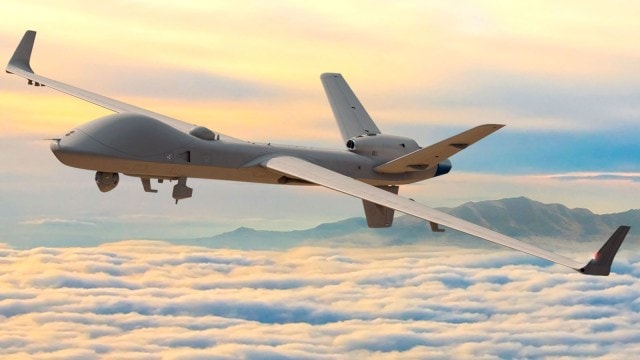SOURCE: PTI

The MQ9-B SkyGuardian Aircraft being sold to India by the US would be equipped with highly sensitive surveillance and lethal attack equipment including hellfire missile, and laser small diameter bombs, according to details sent by the Biden Administration to the US Congress.
The Defence Security Cooperation Agency (DSCA) wrote a letter to the Congress last week informing it that the State Department has made a determination approving a possible Foreign Military Sale to the Government of India of MQ-9B Remotely Piloted Aircraft and related equipment for an estimated cost of USD 3.99 billion.
Addressed to Senator Ben Cardin, who is Chairman of the Senate Foreign Relations Committee, the letter was tabled on the Senate floor on Monday.
As per the letter, which has a significant classified section given the nature of the defence equipment and technology, the 31 SkyGuardian drones, manufactured by General Atomics Aeronautical Systems, along with the services and equipment is being sold to India at an estimated cost of USD3.9 billion.
The 31 MQ9-B SkyGuardian drones itself costs USD 1.70 billion, while the rest of the services including technology and equipment is estimated to cost USD 2.29 billion. In addition to 31 MQ-9B SkyGuardian drones, the proposed deal includes 161 Embedded Global Positioning & Inertial Navigation Systems (EGIs), 35 L3 Rio Grande Communications Intelligence Sensor Suites.
It includes 170 AGM-114R Hellfire Missiles, 16 M36E9 Hellfire Captive Air Training Missiles, 310 GBU-39B/B Laser Small Diameter Bombs (LSDB) and eight GBU-39B/B LSDB Guided Test Vehicles (GTVs) with live fuzes. These prices are subject to further negotiations by the Indian Government.
DSCA has informed Congress that MQ-9B Remotely Piloted Aircraft (RPA) is a weapons-ready aircraft designed for Medium-Altitude Long-Endurance (MALE); Intelligence, Surveillance, and Reconnaissance (ISR); Target Acquisition; and Strike Missions.
Further it is a highly modular, easily configurable aircraft that contains the necessary hard points, power, and data connections to accommodate a variety of payloads and munitions to meet multiple missions–including counter-land, counter-sea, and anti-submarine strike operations.
It will be equipped with MX-20HD gyro-stabilized, multi-spectral, multi-field-of-view (FOV) Electro-Optical/Infrared (EO/IR) targeting system, which provides surveillance laser illumination and laser designation through use of an externally mounted turret sensor unit and internally mounted master control.
Informing the Congress that the Ground Control Station (GCS) in the system can be either fixed or mobile, the US Government told the Congress that L3 Rio Grande capabilities meet rigorous mission requirements for small, manned and unmanned intelligence, surveillance, and reconnaissance (ISR) platforms.
The AGM-114R Hellfire missile in these drones would be equipped with a Semi-Active Laser (SAL) and can be launched from higher altitudes than previous variants because of its enhanced guidance and navigation capabilities, which include a Height-of-Burst (HOB) proximity sensor. With its multi-purpose warhead, the missile can destroy hard, soft, and enclosed targets.
The GBU-39B/B Laser Small Diameter Bomb (LSDB) All Up Round (AUR) to be installed in these drones are is a 250-pound OPS and semi-active laser guided, small autonomous, day or night, adverse weather, conventional, air-to-ground precision glide weapon able to strike fixed and stationary, relocatable, non-hardened targets from standoff ranges.
According to Congressional documents, the LSDB’s laser guidance set enables the weapon to strike moving targets. It is intended to provide aircraft with an ability to carry a high number of bombs. Aircraft are able to carry four SDBs in place of one 2,000-pound bomb.
The Automatic Identification System (AIS) transponder provides maritime patrol and Search and Rescue (SAR) aircraft with the ability to track and identify AIS-equipped vessels over a dedicated very high frequency (VHF) data link.
Notably, AIS is a key component of any maritime ISR network and offers maritime authorities with the ability to better coordinate air and sea search, rescue, surveillance, and interdiction operations.
At the same time, the Pentagon did not share all the information in the non-classified domain noting that the highest level of classification of defence articles, components, and services included in this potential sale is SECRET.
“If a technologically advanced adversary were to obtain knowledge of the specific hardware and software elements, the information could be used to develop countermeasures that might reduce weapon system effectiveness or be used in the development of a system with similar or advanced capabilities,” it said.
The notification told Congress that a determination has been made that India can provide substantially the same degree of protection for the sensitive technology being released as the US Government. “This sale is necessary in furtherance of the US foreign policy and national security objectives,” it said.